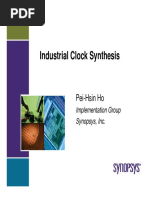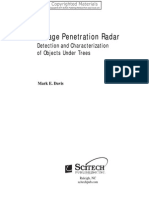Pattern Generation Methods An Intro To DFT Course
Uploaded by
Naga NitheshPattern Generation Methods An Intro To DFT Course
Uploaded by
Naga NitheshAn Introduction to DFT
Pattern Generation | Topic 6 of 10
“ Abstract
In DFT, a manufacturing defect, whether it is due to Stuck-at, bridging,
switching, or delay faults, the only way to find out is to apply certain test
patterns as per the type of fault it is; we have seen that these patterns can be
transferred into fault site through a scan chaining flops and is the most widely
used & cheap method of achieving DFT; but we have derived the patterns with
the help of truth table so far and this is not the way how the patterns are
generated practically; in this section, we’ll try to look at different ways to
generate patterns with pros & cons associated with it.
1
Where We are?
Fault Models Pattern Generation DFT Techniques
• Stuck at faults • Pattern • Scan Insertion
• Bridging faults generation • Scanned
• Delay faults • Fault simulation Flipflop
• Switch level • ATPG • Boundary scan
• Pattern (JTAG)
faults
generation • BIST
algorithms
Copyright @ Tanmoy Das, 2021
2
What is Pattern Generation (PG)?
• The aim of test generation at the gate level is to verify that
each logic gate in the circuit is functioning correctly, and the
interconnections are good
• We apply a specific set of signals to the circuit input as a
test to identify a certain fault as per fault model considered
for example, a SA0/1 at a certain node or a delay in a gate
etc. this is known as the Test Vector,
• To detect all the stuck-at faults, we need to apply a series of
test vectors sequentially, this series is also known as the
Test Pattern, here our task is to generate patterns
Copyright @ Tanmoy Das, 2021
3
Pattern Generation problems
• The simplest way to test these designs is by verifying the
responses to all input combinations, this can be done by
applying each input combination and observing each
corresponding output, called exaustive testing
• Here, for n input signals one has to consider 2n no of single
SA faults & path delay faults, 3K-1 nos of multiple SA faults
etc. as discussed previously, this means there are huge no
of set of test vectors or test patterns are associated with,
• What would happen there are millions of gates in a design?
The number of test vectors would grow drastically
Copyright @ Tanmoy Das, 2021
4
Pattern Generation problems
• With a clock frequency of100 MHz, a tester would take
probably 300 ms & 130 days!! for a 25 & 50 input designs
respectively
• Also, have to store all 250 Golden or reference responses for
the comparions with responses from the faulty design,
memory requirement increases exponentially with no of states
to compare
• A tester is a device where designs are tested after fabrication,
it is a clock speed & memory constrained device , ex. Agilent
93000 SOC Series tester has a 1024 Pins Testhead
Copyright @ Tanmoy Das, 2021
5
Pros & cons of Truth Table approach
• The most straightforward method for generating tests for a
particular fault is to compare the truth-table of the fault-free
and the faulty circuits
• It is less time consuming than ‘exhaustive testing’, where for
n inputs one has to apply 2n input patterns
• But a kind of manual approach to match the response form
faulty design, not suitable for automatic generation of
patterns
Copyright @ Tanmoy Das, 2021
6
Other Pattern Generation Methods
• All though TT method is streight forward it is not suitable for
when no of tests are very large, there are slightly improved
approaches:
1. Boolean Difference Method
2. Path Sensetization Method
Copyright @ Tanmoy Das, 2021
7
Boolean Difference Method
• The basis of this method is Fgood Ffaulty = 1, where F is the
response of a given combinational circuit
• If the given combinational circuit is F = f(A,B,C,....), where
A,B,C .. are the inputs to the circuit, then the circuit can be
represented with the help of Shanon’s expansion around
input A will be:
= . = + . =
Copyright @ Tanmoy Das, 2021
8
Boolean Difference Method contd.
• If we consider a single Stuck At fault at A, which can be SA0
& SA1 we can write the following:
⊕ = 1, for a SA0 Fault ...... (1)
⊕ = 1, for a SA1 Fault ...... (2)
• Let us take the example of SA1 fault and try to establish a
relation from equation 2 by expressing F in terms of
Shannon’s Expansion:
Copyright @ Tanmoy Das, 2021
9
Boolean Difference Method contd.
⊕ = 1
⇒ (A. + . )⊕ =1
⇒ (A. + . ). + (A. + . ). =1
By applying De-Morgan’s Theorem & simplifying LHS we can write the following:
⇒ ( ⊕ ) = 1 ................... (3)
The term ⊕ is called Boolean difference and is denoted by:
= ⊕ .............. (4)
Copyright @ Tanmoy Das, 2021
10
Boolean Difference Method contd.
So for a SA1 fault the relation from equation 3 can be written as:
. = 1 ........ (5)
Similarly, we can write same relationship for a SA0 fault as:
A. = 1 ........ (6)
Where Boolean difference can be found from equation 4
• Now, please note that the input combination for which the equation
5 satisfies are the input vectors for a SA1 fault & similarly equation 6
for a SA0 fault
Copyright @ Tanmoy Das, 2021
11
Boolean Difference Example,
In the given circuit find out patterns for a SA1 using boolean difference method
=( + ) + .( + ) , we have to calculate
A F
Here
. = 1 for SA1 & A. = 1 for SA0
B
C
Here, = ⊕ ,
Equation 7 is the relation for
=( + ) + 1. ( + )=0 SA1 fault, and the set of
=( + ) + 0. ( + ) = + pattern satisfying it is {0XX},
= + , and . = 1 => . + = 1 ...... (7)
Test vectors {000, 010,001}
Copyright @ Tanmoy Das, 2021
12
Boolean Difference Example,
To verifiy if the obtained pattern from Boolean Expression let us cosider the TT
SA1 1
A B C F FSA1 A F
0 0 0 1 0
B
0 0 1 1 0 C
0 1 0 1 0
0 1 1 1 0 • It is clear from the TT that the
1 0 0 0 0 pattern is {0XX}, and is same
1 0 1 0 0 as obtained in Boolean
1 1 0 0 0
Difference Method
1 1 1 0 0
Copyright @ Tanmoy Das, 2021
13
Boolean Difference Pros & cons
• Boolean difference takes much lesser time as compared to
Exaustive testing & even with Truth Table based approach
• It is a Mathematics based approach can be implemented
using softwares, and hence reduces human efforts to
generate patterns
• At the last step we have to findout input combinations, that
satisfy Fgood Ffaulty = 1 relation, suitable algorithm has to
be find out for this purpose, sometimes it is complex
Copyright @ Tanmoy Das, 2021
15
Path Sensitization Method Intro
• The key point in Boolean Difference is one has to know the
‘Logical Expression’ of the given circuit, F = f(A,B,C,....)
• But in practical cases such opportunities are not avaliable,
infact after synthesis DFT activity starts with the ‘netlist’,
which is just an interconnection of logic gates but no
information of ‘Logical Expression’
• So, in practical cases this method can’t be used, rather a
familly of PG methods is based on Path Sensitization
Method which as advantages over previos methods
Copyright @ Tanmoy Das, 2021
16
Path Sensitization Method
• Path Sensitization Method has 3 basic steps which doesn’t
require any logical expression of a given circuit, the steps
are:
1. Fault excitation
2. Forward Propagation
3. Backward Propagation
• With an example let’s try to understand the method
Copyright @ Tanmoy Das, 2021
17
Path Sensitization | Fault excitation
• It is the step where a Fault is introduced at the fault site by
forcing the net by an opposite value signal to which it is
stuck-at.
Forcing 0 at A
Let us take the previous circuit & try 0 Y
A F
to generate pattern through each step,
Consider a SA1 fault, B
C X Z
Copyright @ Tanmoy Das, 2021
18
Path Sensitization | Forward Propagation
• The effect of forcing is propagated till the primary output
where the resultant logical value is observed
After forcing A to 0, the effect is propagated Forced 0 at A 0
Y
along path A-Y-F & note that the result of A F
D
forcing at Y is denoted as D and it is B
propaged along the said path, now as the C X Z
Last gate is NOR and the only way to detect
the descrypency D is to observe F =
Copyright @ Tanmoy Das, 2021
19
Path Sensitization | Backward Propagation
• Once the path has been sensitized successfully, we just
need to traverse behind every gate and assign the desired
value to the net until we reach the primary inputs
For F = , Z has to be 0, which requires X = 1, Forced 0 at A 0
Y 0
for that BC needs to be {01 or 10} A F
D
Now A=0(forced), so D = 0, F = 1, hence the B 1 1
1/0
pattern is {010 or 001} & we observe F to be 1, 0
0/1 C X Z
Note: That the pattern obtained is satisfying
the Boolean difference & TT method which
was {0XX}
Copyright @ Tanmoy Das, 2021
20
Path Sensitization pros & cons
• The main advantage of Path Sensitization is it doesn’t
require any Logical Expression, so it can readily be
applicable to netlist
• Also very fast as compared to TT & boolean difference
method, as there is no of solving differnce equations like in
boolean difference
• But, here at the 3rd stage we need sophisticated backward
propagation algorithm and sometimes it becomes complex
Copyright @ Tanmoy Das, 2021
THANKS!
Any questions?
You can find me at linkedin.com/in/dastanmoy92/ or
tancarrer.ece@gmail.com
You might also like
- ATPG Simulation Mismatch - Common Problems and Solutions100% (1)ATPG Simulation Mismatch - Common Problems and Solutions6 pages
- An Introduction To Scan Test For Test Engineers: Part 1 of 2No ratings yetAn Introduction To Scan Test For Test Engineers: Part 1 of 28 pages
- Clock Gating: Smart Use Ensures Smart ReturnsNo ratings yetClock Gating: Smart Use Ensures Smart Returns4 pages
- Asic Design Flow:: Specification FloorplanNo ratings yetAsic Design Flow:: Specification Floorplan9 pages
- An Introduction To DFT - Bridging & Switch Level Faults100% (1)An Introduction To DFT - Bridging & Switch Level Faults24 pages
- Detailed Explanation of Common Commands of Tessent ToolNo ratings yetDetailed Explanation of Common Commands of Tessent Tool10 pages
- Assignment II - Testability For VLSI DesignNo ratings yetAssignment II - Testability For VLSI Design6 pages
- Thorough Test Means Testing Through The RAMNo ratings yetThorough Test Means Testing Through The RAM2 pages
- Tetramax® Lab: Automatic Test Pattern Generation (Atpg) : Computer-Aided Vlsi System DesignNo ratings yetTetramax® Lab: Automatic Test Pattern Generation (Atpg) : Computer-Aided Vlsi System Design4 pages
- Setup and Hold Time Violation Static Timing Analysis (STA) Basic (Part 3b) VLSI ConceptsNo ratings yetSetup and Hold Time Violation Static Timing Analysis (STA) Basic (Part 3b) VLSI Concepts14 pages
- At-Speed Transition Fault Testing With Low Speed Scan EnableNo ratings yetAt-Speed Transition Fault Testing With Low Speed Scan Enable6 pages
- The Introduction To Edt (Testkompress) : High Test Quality & Low Test CostNo ratings yetThe Introduction To Edt (Testkompress) : High Test Quality & Low Test Cost29 pages
- Design Rule Checks (DRC) - A Practical View For 28nm TechnologyNo ratings yetDesign Rule Checks (DRC) - A Practical View For 28nm Technology5 pages
- DFT Timing Design Methodology For At-Speed BIST: February 2003No ratings yetDFT Timing Design Methodology For At-Speed BIST: February 20037 pages
- Important Mcq-Single Phase Induction Motors - WWW - Allexamreview.comNo ratings yetImportant Mcq-Single Phase Induction Motors - WWW - Allexamreview.com14 pages
- EL7047: Risk and Reliability in Electrical Energy SystemsNo ratings yetEL7047: Risk and Reliability in Electrical Energy Systems22 pages
- POLOLU A4983/A4988: A Getting Started Guide. - DECRNo ratings yetPOLOLU A4983/A4988: A Getting Started Guide. - DECR5 pages
- 1 - KMC-950 Service Manual - Eng - V1.6 - Luna1kNo ratings yet1 - KMC-950 Service Manual - Eng - V1.6 - Luna1k159 pages
- Cable Termination Instruction 11kV Terminations Single Core XLPE EPRNo ratings yetCable Termination Instruction 11kV Terminations Single Core XLPE EPR7 pages
- TBS1000B and TBS1000B EDU Oscilloscope User ManualNo ratings yetTBS1000B and TBS1000B EDU Oscilloscope User Manual154 pages
- SOM6629519 Unit Control System Acceptance Test Procedure100% (2)SOM6629519 Unit Control System Acceptance Test Procedure25 pages
- International Journal of Research Publication and ReviewsNo ratings yetInternational Journal of Research Publication and Reviews5 pages
- Overhead Transmission Lines, Gas Insulated Lines and Underground CablesNo ratings yetOverhead Transmission Lines, Gas Insulated Lines and Underground Cables8 pages
- My Earthing notes, and some journal articles to readNo ratings yetMy Earthing notes, and some journal articles to read1 page
- Foliage Penetration Radar. Detection and Characterization of Objects Under Trees - Mark E Davis100% (1)Foliage Penetration Radar. Detection and Characterization of Objects Under Trees - Mark E Davis374 pages
- Verifiarea - Motoarelor - Electrice - IP-11 - v25No ratings yetVerifiarea - Motoarelor - Electrice - IP-11 - v256 pages
- UAT #1 & #2 Protection Relay Setting & TestingNo ratings yetUAT #1 & #2 Protection Relay Setting & Testing39 pages
- 1MRK508002-BEN - en - C - Time Relays RXKL 1 and RXKM 2HNo ratings yet1MRK508002-BEN - en - C - Time Relays RXKL 1 and RXKM 2H5 pages
- SATURN EVOC Technical Manual 1edition 17112006100% (2)SATURN EVOC Technical Manual 1edition 17112006157 pages
- Electricity Generating Shock Absorber - Seminar Report, PPT, PDF For MechanicalNo ratings yetElectricity Generating Shock Absorber - Seminar Report, PPT, PDF For Mechanical4 pages
- ATPG Simulation Mismatch - Common Problems and SolutionsATPG Simulation Mismatch - Common Problems and Solutions
- An Introduction To Scan Test For Test Engineers: Part 1 of 2An Introduction To Scan Test For Test Engineers: Part 1 of 2
- An Introduction To DFT - Bridging & Switch Level FaultsAn Introduction To DFT - Bridging & Switch Level Faults
- Detailed Explanation of Common Commands of Tessent ToolDetailed Explanation of Common Commands of Tessent Tool
- Tetramax® Lab: Automatic Test Pattern Generation (Atpg) : Computer-Aided Vlsi System DesignTetramax® Lab: Automatic Test Pattern Generation (Atpg) : Computer-Aided Vlsi System Design
- Setup and Hold Time Violation Static Timing Analysis (STA) Basic (Part 3b) VLSI ConceptsSetup and Hold Time Violation Static Timing Analysis (STA) Basic (Part 3b) VLSI Concepts
- At-Speed Transition Fault Testing With Low Speed Scan EnableAt-Speed Transition Fault Testing With Low Speed Scan Enable
- The Introduction To Edt (Testkompress) : High Test Quality & Low Test CostThe Introduction To Edt (Testkompress) : High Test Quality & Low Test Cost
- Design Rule Checks (DRC) - A Practical View For 28nm TechnologyDesign Rule Checks (DRC) - A Practical View For 28nm Technology
- DFT Timing Design Methodology For At-Speed BIST: February 2003DFT Timing Design Methodology For At-Speed BIST: February 2003
- Important Mcq-Single Phase Induction Motors - WWW - Allexamreview.comImportant Mcq-Single Phase Induction Motors - WWW - Allexamreview.com
- EL7047: Risk and Reliability in Electrical Energy SystemsEL7047: Risk and Reliability in Electrical Energy Systems
- POLOLU A4983/A4988: A Getting Started Guide. - DECRPOLOLU A4983/A4988: A Getting Started Guide. - DECR
- Cable Termination Instruction 11kV Terminations Single Core XLPE EPRCable Termination Instruction 11kV Terminations Single Core XLPE EPR
- TBS1000B and TBS1000B EDU Oscilloscope User ManualTBS1000B and TBS1000B EDU Oscilloscope User Manual
- SOM6629519 Unit Control System Acceptance Test ProcedureSOM6629519 Unit Control System Acceptance Test Procedure
- International Journal of Research Publication and ReviewsInternational Journal of Research Publication and Reviews
- Overhead Transmission Lines, Gas Insulated Lines and Underground CablesOverhead Transmission Lines, Gas Insulated Lines and Underground Cables
- My Earthing notes, and some journal articles to readMy Earthing notes, and some journal articles to read
- Foliage Penetration Radar. Detection and Characterization of Objects Under Trees - Mark E DavisFoliage Penetration Radar. Detection and Characterization of Objects Under Trees - Mark E Davis
- 1MRK508002-BEN - en - C - Time Relays RXKL 1 and RXKM 2H1MRK508002-BEN - en - C - Time Relays RXKL 1 and RXKM 2H
- Electricity Generating Shock Absorber - Seminar Report, PPT, PDF For MechanicalElectricity Generating Shock Absorber - Seminar Report, PPT, PDF For Mechanical











































































































